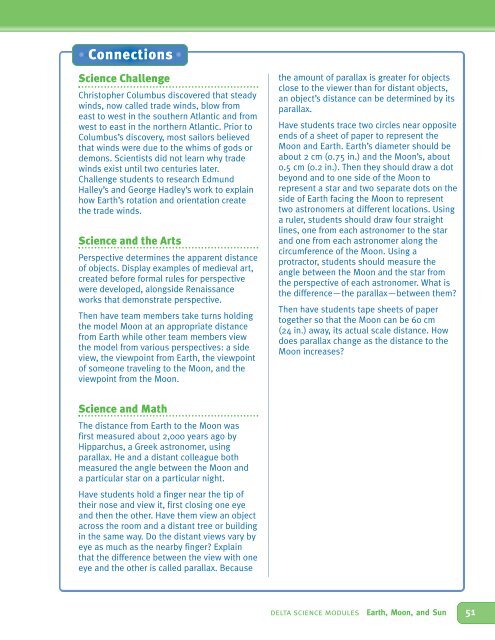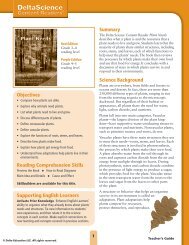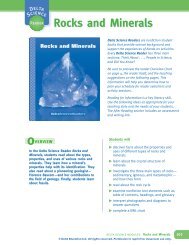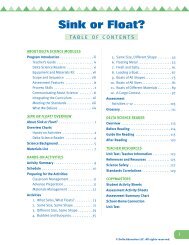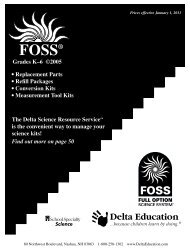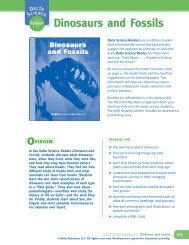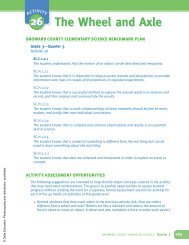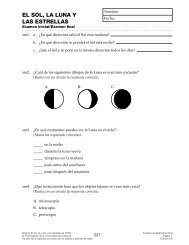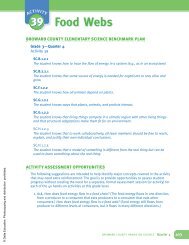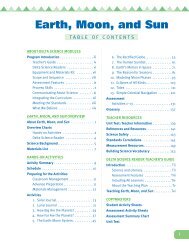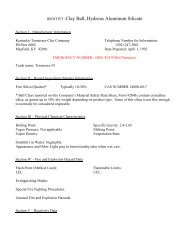The Earth-Moon System The Earth-Moon System - Delta Education
The Earth-Moon System The Earth-Moon System - Delta Education
The Earth-Moon System The Earth-Moon System - Delta Education
You also want an ePaper? Increase the reach of your titles
YUMPU automatically turns print PDFs into web optimized ePapers that Google loves.
ConnectionsScience ChallengeChristopher Columbus discovered that steadywinds, now called trade winds, blow fromeast to west in the southern Atlantic and fromwest to east in the northern Atlantic. Prior toColumbus’s discovery, most sailors believedthat winds were due to the whims of gods ordemons. Scientists did not learn why tradewinds exist until two centuries later.Challenge students to research EdmundHalley’s and George Hadley’s work to explainhow <strong>Earth</strong>’s rotation and orientation createthe trade winds.Science and the ArtsPerspective determines the apparent distanceof objects. Display examples of medieval art,created before formal rules for perspectivewere developed, alongside Renaissanceworks that demonstrate perspective.<strong>The</strong>n have team members take turns holdingthe model <strong>Moon</strong> at an appropriate distancefrom <strong>Earth</strong> while other team members viewthe model from various perspectives: a sideview, the viewpoint from <strong>Earth</strong>, the viewpointof someone traveling to the <strong>Moon</strong>, and theviewpoint from the <strong>Moon</strong>.the amount of parallax is greater for objectsclose to the viewer than for distant objects,an object’s distance can be determined by itsparallax.Have students trace two circles near oppositeends of a sheet of paper to represent the<strong>Moon</strong> and <strong>Earth</strong>. <strong>Earth</strong>’s diameter should beabout 2 cm (0.75 in.) and the <strong>Moon</strong>’s, about0.5 cm (0.2 in.). <strong>The</strong>n they should draw a dotbeyond and to one side of the <strong>Moon</strong> torepresent a star and two separate dots on theside of <strong>Earth</strong> facing the <strong>Moon</strong> to representtwo astronomers at different locations. Usinga ruler, students should draw four straightlines, one from each astronomer to the starand one from each astronomer along thecircumference of the <strong>Moon</strong>. Using aprotractor, students should measure theangle between the <strong>Moon</strong> and the star fromthe perspective of each astronomer. What isthe difference—the parallax—between them?<strong>The</strong>n have students tape sheets of papertogether so that the <strong>Moon</strong> can be 60 cm(24 in.) away, its actual scale distance. Howdoes parallax change as the distance to the<strong>Moon</strong> increases?Science and Math<strong>The</strong> distance from <strong>Earth</strong> to the <strong>Moon</strong> wasfirst measured about 2,000 years ago byHipparchus, a Greek astronomer, usingparallax. He and a distant colleague bothmeasured the angle between the <strong>Moon</strong> anda particular star on a particular night.Have students hold a finger near the tip oftheir nose and view it, first closing one eyeand then the other. Have them view an objectacross the room and a distant tree or buildingin the same way. Do the distant views vary byeye as much as the nearby finger? Explainthat the difference between the view with oneeye and the other is called parallax. Becausedelta science modules <strong>Earth</strong>, <strong>Moon</strong>, and Sun 51


